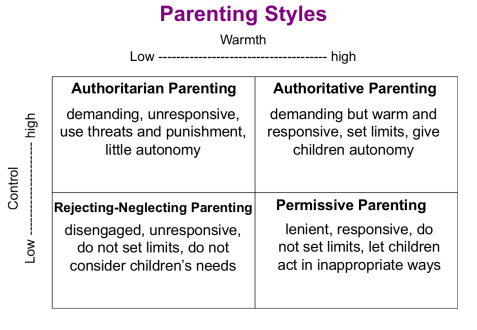Parents play an important role in their children’s lives, not only by providing essential nourishment and care, but also by providing emotional and social support.
Psychologists have studied the ways parents “parent” since the 1960s; over time, they have tried to classify the range of parenting practices as they observe them. Importantly, research shows that the different types of parenting have implications for children’s academic achievement, mental health and emotional development later in their lives.
Parenting type or style is typically measured on two dimensions — warmth and control. Parents who are high in warmth are accepting and affectionate. They listen to their children and include children in decision making, and they respond to their children’s physical and emotional needs.
In contrast, parents who are low in warmth are less responsive, more rejecting and have trouble expressing affection to their children.
Parents who are high in control set limits for their children and are clear about what these limits are. They explain when certain behaviors are appropriate and how much is allowed. Importantly, these parents also have high expectations for their children. They expect a lot from their children but provide the appropriate guidelines to help them meet those expectations.
Parents who are low in control are often described as permissive. They set few limits, and they typically allow their children to do whatever they want.
The combination of these dimensions results in four general categories, which were termed by Diane Baumrind as the Four Parenting Styles: Authoritarian, Authoritative, Rejecting-neglecting and Permissive.

Psychologists typically regard authoritative parenting – the style in which parents are high in warmth and control – as the best in terms of providing children with the emotional and psychological support they need. Research shows that authoritative parents have children that are more likely to succeed in school, have less problem behaviors, and experience less mental illness.
What make authoritative parenting effective is not only the structure it provides, but because children understand why rules are set. Expectations are not arbitrary, and because these parents are loving and responsive, there is value in their approval and disapproval. Children of authoritative parents are challenged to meet their potential, which helps them build self-control and self-confidence.
Unfortunately, the outcomes for children whose parents exhibit the other three parenting styles are less positive. For example, children of authoritarian parents are more likely to experience depression and have poor coping skills. Children of permissive parents are more likely to be impulsive and exhibit problem behaviors in school. Rejecting-neglecting parents, unsurprisingly, have children who have trouble forming healthy relationships and sometimes exhibit anti-social behaviors.
Are these children doomed to grow up with problems?
Not necessarily. First, most studies show that authoritative parenting is the most common parenting style in the U.S. Second, research suggests that different parenting styles may be more beneficial depending on culture. For example, authoritarian parenting has more positive outcomes for African-American families compared to white families, potentially because African-American children are more likely to grow up in environments where safety is a priority.
The bottom line: The degree to which parents exhibit warmth and control matters for children’s development. However, it’s important to remember that the degree of control needs to be appropriate to children’s age and abilities. For example, it might be unreasonable to expect a 2-year old to sit still while reading a book together. Here, punishing a child might seem arbitrary because the child may not understand why they are being punished. Therefore, parents should aim to set high but reasonable expectations for children while showing them responsiveness and unconditional love.
